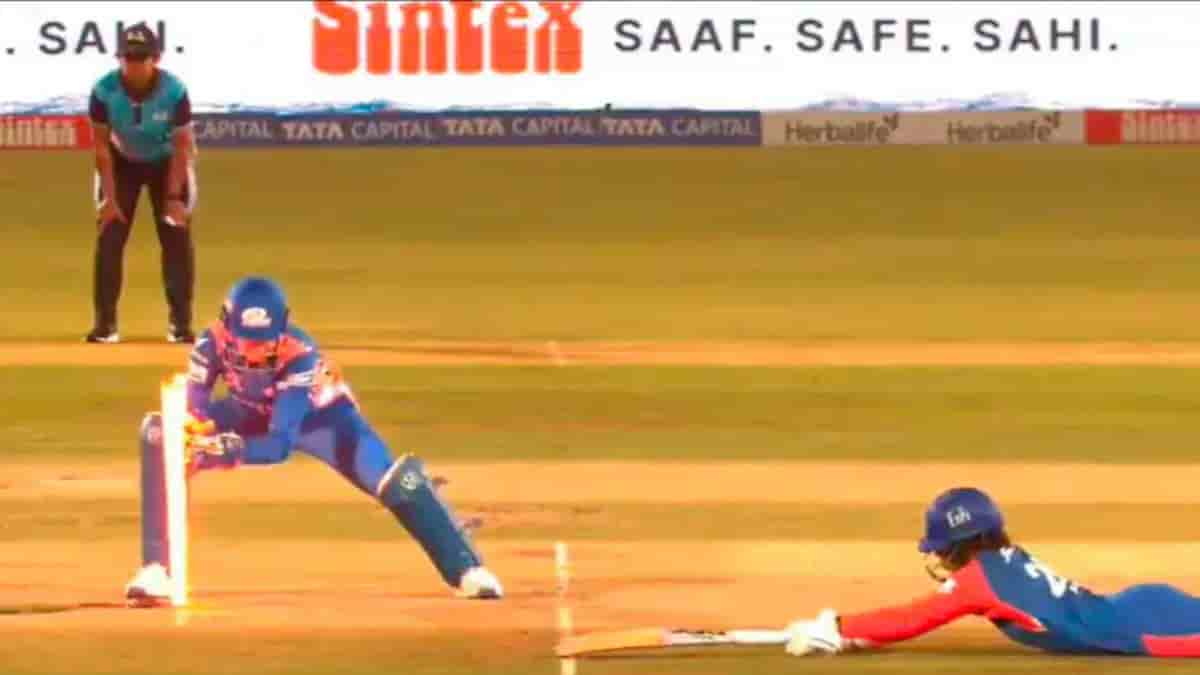
The 2025 Women’s Premier League (WPL) has seen a rule change introduced in response to concerns over the utilization of LED bails, which have been at the center of controversy in a recent fixture between Delhi Capitals (DC) and Mumbai Indians (MI). The rule change was initiated due to a lack of LED bails and uncertainty regarding the manner in which the bails were being activated.
The modification seeks to specify when a wicket is deemed broken in cases of run-outs and stumpings so that a more precise decision-making process is adopted in the future.
Controversy Surrounding Run-out Decisions in DC vs MI Match

This problem surfaced during the game played between the Delhi Capitals and the Mumbai Indians on February 15, 2025; a few of the run-out decisions made people sit up. The decisions were, however, chiefly based on the use of LED bails, which are designed to glow when the bails are taken off the stumps.
Yet for this particular match, the bails were lit before being dislodged completely from the stumps, creating confusion regarding when the wicket could be considered broken.
The problem had been that the LED bails used in the WPL were overly sensitive, triggering the light with the slightest disturbance to the bails. At times, the bails weren’t even completely dislodged but the light would still activate.
This activation, so quickly after the bails were moved, aroused suspicion in the accuracy of the third umpire’s decisions as the umpire’s final word was dependent on the light’s activation instead of the lifting of bails off the stumps.
New Rule: Wickets Will Be Deemed Broken Only When Bails Are Fully Lifted
In the wake of controversy and widespread reprimands from match officials, the WPL was able to project changes in rules to enable clarity and fairness for such cases. According to this new rule, there needs to have been full dislodging of the LED bails from the stumps in cases involving run-outs and stumpings. It must be noted that this rule eliminates the previous one that allowed any light activation to indicate the bail was dislodged, even if it was not completely lifted.
The new rule stipulates that the third umpire must wait for the bails to be entirely disengaged from the stumps before making a call. This change comes in response to the problem of the LED bails lighting prematurely if the bails had not actually yet been fully removed from their rests on the stumps. With complete bails off first, this should make the decisions more convincing and conform to conventional cricketing tradition.
Necessity behind the rule change
The change in the rule was spurred by the problems encountered while using LED bails during the WPL. The microprocessor-equipped bails are designed to glow when displaced from their settled positions on the stumps, which indicates the chances of a wicket.
However, they glowed during the WPL 2025 even when they had not fully come off the stumps, causing great confusion at pivotal moments of the match. The premature flashing of bails proved to be very disruptive in cases of run-outs and stumpings, where precision is crucial.
The minimal amount of time it took for the bails to get completely dislodged from the stumps would at times result in the light switching on prematurely, which was not a true reflection of the wicket. For this reason, the third umpire during the DC vs MI match, Gayatri Venugopalan, had to factor in the limited amount of time it took for the bails to get fully lifted before reaching her final judgment. This was followed by three run-out decisions that were extremely controversial and helped to fuel the controversy of the match.
Implementation of the Rule Change
The new rule was informed to match officials before the DC vs MI match so that they were aware of the new approach. The teams, however, were only made aware of the rule change after the match was played, causing some frustration and confusion. Although the match officials were informed about the rule change beforehand, the delay in communicating it to the teams created some anxiety since they could not make any changes in their strategies or interpretation of the decision-making process during the course of the game.
This rule change has been delayed in communicating to the groups involved, although it has been introduced to enhance the integrity and accuracy of future matches. With this adjustment, the league aims to deal with the complaints raised in the DC vs MI match and, by extension, prevent those controversies from arising for the rest of the tournament.
Impact of the Rule Change on the Rest of the Tournament
Since the change in the rule has been implemented, third umpires and teams will have to get used to the new criterion for determining run-outs and stumpings. The umpires will have to wait until the bails are entirely dislodged from the stumps before they can make a ruling, thereby ensuring there is no uncertainty in the ruling of wickets. This modification is expected to reduce any potential future controversies surrounding the application of LED bails and enhance decision precision throughout the event.
For the teams, the knowledge of this change is also important for their strategies, since they might approach run-out and stumping matters differently now, knowing how quickly the bail is removed will be the most important consideration for the umpire in making the decision. The change should help players feel more confident about the fairness of decisions being made.
ALSO READ: Kane Williamson’s Hundred Debut: Signs with London Spirit





